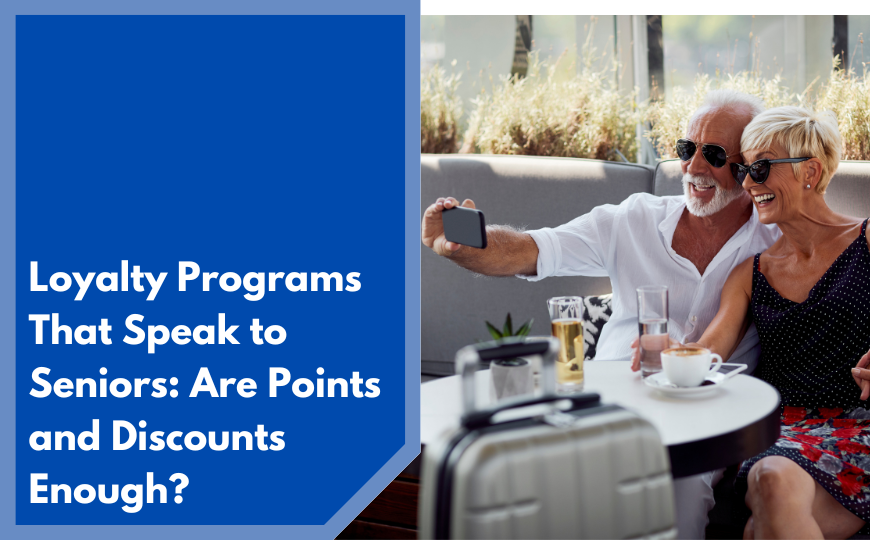Loyalty programs are a proven way to build customer retention, encourage repeat business, and strengthen relationships. For industries serving the aging population, however, traditional models based on points and basic discounts may not go far enough. Why not? The senior demographic has unique preferences, values, and expectations that deserve a different approach.
More than ever, today’s older adults are savvy consumers. They’re not just making business transactions with trusted brands. Instead, they’re loyal when given real value and treated with respect. For example, a free coffee after ten purchases won’t cut it. Seniors want to know that your business sees them, understands them, and is ready to support their needs.
So, how do you design a loyalty program that actually speaks to seniors? Let’s dig into what makes older consumers tick and how your brand can win their long-term trust.
What Do Seniors Expect from Loyalty Programs?
Older adults are not generally swayed by the same tactics that work for younger demographics. Rather, they prioritize meaningful value, personal attention, and clear communication.
- Value beyond price. Discounts are appreciated, but seniors often care more about convenience, support, and reliability. A loyalty program that offers easier access to services, better communication, or dedicated assistance may mean far more than 10% off.
- Trust over flash. Seniors are less interested in gamified or overly complex systems. They’re drawn to programs that are simple to understand, easy to use, and clearly beneficial.
- Community and belonging. Aging in place individuals value human connection. Loyalty perks that build community like exclusive events, early access to services, and personal check-ins go a long way.
If your program only focuses on transactional benefits, you may be missing an opportunity to build emotional loyalty, which is something that’s especially powerful with your target audience.
How Can You Build a Senior-Centric Loyalty Program?
1. Make It Personal
A great loyalty program should feel less like a blanket promotion and more like a personalized invitation. Older customers want to feel seen, so they appreciate recognition that goes beyond a name in a database.
Use data on purchase history or customer preferences to personalize offers and communications. For instance, your company might send seasonal recommendations based on previously purchased items, or provide exclusive health tips curated for the customer’s lifestyle.
Simple gestures like birthday cards, anniversary messages, or special offers for long-time members also build goodwill and help your brand feel more human.
2. Offer Services, Not Just Discounts
Think of loyalty in terms of services that enhance your customers’ lives more than a flat rate discount. For example:
- Priority scheduling for appointments or deliveries.
- Free consultations or product set-up assistance.
- A dedicated phone line or customer service rep for loyalty members.
These kinds of benefits are especially valuable for older adults who prioritize ease, support, and familiarity over deals or promotions. Offering peace of mind through these added services can be even more compelling than saving a few dollars.
3. Create a Sense of Belonging
One of the most powerful forms of loyalty is emotional loyalty, which is when your customers feel truly connected to your brand. This comes from relationships, not from points.
Start by hosting small local events, offering access to an exclusive email newsletter with tips and stories, or recognizing specific customers in your communications.
For example, your company could feature a “Customer of the Month” or share testimonials from older adults who have benefitted from your solutions. These real-life connections reinforce a sense of community, and community builds loyalty.
4. Keep It Simple
Ease of use is non-negotiable. Many older consumers won’t engage with a loyalty program that feels like a maze of apps, sign-ins, and terms and conditions.
Keep enrollment easy, whether you go with an online, in person, or over the phone system. Provide clear explanations of how the program works, and use large fonts, simple layouts, and plain language to win extra points with seniors.
Additionally, experiment with the type of point system that resonates most with your audience. For example, instead of “earn 1 point per $1 spent and get 100 points for a $5 coupon,” try, “After 5 purchases, your next order is 20% off.” Aim for clear, simple, and impactful.
5. Ask for Actionable Feedback
Want to know what your senior customers value the most? Ask them!
Survey your loyalty members or hold focus groups with longtime customers to understand what they want in a rewards program. Their insights may surprise you, and they’ll appreciate being part of the process.
Better yet, let them know how you’re using their input. For instance, “We heard your request for easier tracking, so now your rewards balance is printed on every receipt.”
This kind of responsive communication shows you’re listening, which builds trust and deepens connection.
What Could a Senior-Centric Loyalty Program Look Like?
Imagine that you run a mobility equipment company serving older adults. Instead of simply offering 10% off every fifth purchase, you build a loyalty program with:
- Priority repair scheduling for members
- Access to a quarterly newsletter with health and wellness tips
- Personalized product suggestions from a dedicated support team
- Annual in-store community events for loyal customers
Each offer speaks to your audience’s specific values: convenience, trust, and human connection. Not only does this program reward loyalty, but it also earns it.
Ready to Rethink What Loyalty Looks Like?
Seniors don’t just want points. They want to feel valued. When your loyalty program is designed to reflect their needs, you’ll do more than generate repeat purchases. You’ll earn lifelong advocates.
For more practical insights on engaging senior consumers and growing your impact in the market, subscribe to our biweekly Aging in Place newsletter. We’re here to help you serve this important audience with care, expertise, and smart strategy!






